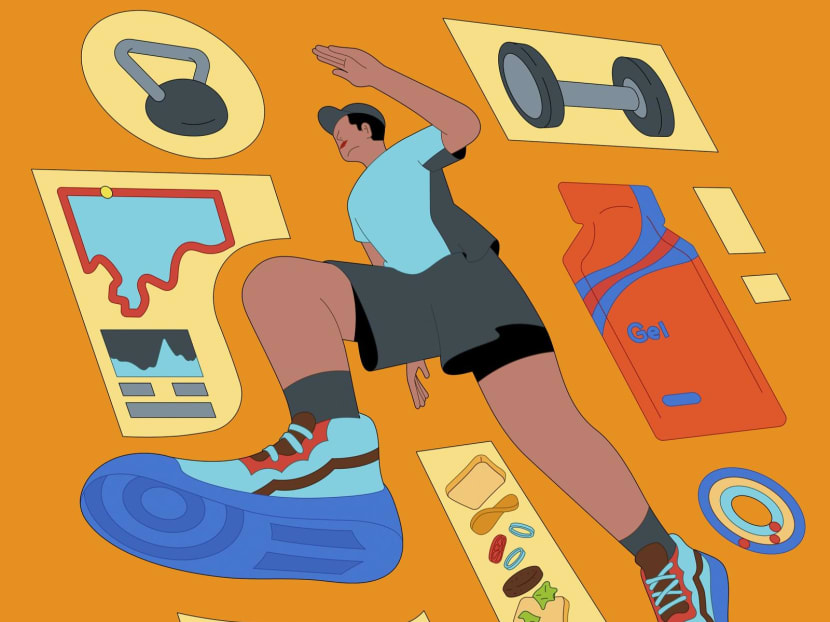6 running myths that could be slowing you down: Energy gels, lactic acid and more
Physical therapists, coaches and other experts want to correct these common misconceptions about the sport.

(Art: The New York Times/Jiaqi Wang)
For such a simple sport, running can generate intense debate – and conflicting advice. And as runners get deeper into the sport and start logging more miles, it can be harder to find reliable information.
Consider the recent swing of the pendulum in running-shoe design, said Matthew Moran, a professor of exercise science at Sacred Heart University in Connecticut. In the early 2010s, minimalist running shoes were trendy, thanks in part to the best-selling book Born To Run and its claim that the way to stay injury-free was to avoid extra cushioning. But soon, the so-called barefoot shoe craze had fizzled out, and shoes were suddenly more thickly cushioned than ever before.
The rise of these maximalist shoes, Dr Moran said, has led some people to believe that they are less likely to get hurt because they think they are striking the ground with less force when they run. But that’s not true, he said. And while some runners may benefit from more cushioning, it’s not clear that it can help prevent injury.
To help set the record straight on other misconceptions about the sport, we asked physical therapists, coaches and other running experts about the biggest myths they would like to debunk.
MYTH 1: DISTANCE RUNNERS DON’T NEED TO LIFT WEIGHTS
Many runners believe that logging more miles is always the best way to improve, said Alison McGinnis, the clinical director at Finish Line Physical Therapy in New York. But, to run faster and be more resilient to injury over the long term, Dr McGinnis said that all runners should also strength train.
Muscle strength and tendon health are crucial for injury prevention, McGinnis said. If you run too much without building up your strength, she added, “down the line something’s going to give.”
MYTH 2: YOU DON’T NEED TO EAT AFTER A RUN
It’s fairly common to have less of an appetite right after a hard run. Some studies suggest that this may be because intense exercise can decrease your body’s production of ghrelin, a hormone that causes hunger. Exercise can also cause a spike in a metabolite that suppresses your appetite.
This temporary feeling can be misleading, said Kristy Baumann, a registered dietitian in Minneapolis who specialises in working with runners. Just because you don’t have an appetite, that doesn’t mean your body doesn’t need food, Baumann said.
“We often hear, ‘Oh, listen to your body’ and ‘Eat when you’re hungry,’” she said, “but this is one of those times when we have to apply sports nutrition knowledge.” But you should have a post-run meal or snack to refuel – otherwise you can slow down your recovery.
MYTH 3: LACTIC ACID CAUSES MUSCLE SORENESS
Despite being debunked by researchers decades ago, the idea that lactic acid causes sore muscles remains pervasive in exercise culture.
Scott Murr, an assistant professor of health sciences at Furman University in South Carolina, said he recently asked a class of more than 20 student-athletes whether lactic acid caused muscle soreness. Every student answered that it did.
Lactate, an energy source your body produces as it breaks down glucose, is often “guilty by association,” Dr Murr said. During intense exercise, lactate production is usually accompanied by an increase in hydrogen ions, which can contribute to a temporary “burning” sensation.
But post-exercise soreness is not related to such metabolic stresses, Dr Murr said. Rather, it is caused by the microscopic damage that happens when you put unusually high demands on your muscles. (Think: The gruelling final stretch of a race.)
MYTH 4: ENERGY GELS ARE ALWAYS TOUGH ON THE STOMACH
As energy gels have become more common in the running world, some athletes have complained that such products cause gastrointestinal distress, Baumann said.
But the gels themselves aren’t necessarily the problem, she said. Sometimes, runners are taking them when they are already dehydrated, which can aggravate stomach issues. Or, they don’t realise that their bodies might need some time to adapt to digesting gels.
“Your stomach is a muscle; it can be trained,” Baumann said. She recommends starting with a small amount of carbohydrates on long runs – half of an energy gel with water every 40 minutes – and working up to one gel every 30 minutes paired with a sports drink.
This gradual progression trains your digestive system to absorb fuel more efficiently, which can help you perform better on race day, Baumann said.
MYTH 5: REST IS ALWAYS THE BEST WAY TO HEAL AN INJURY
The words any runner hates to hear are: “You need to rest until this gets better.” This advice certainly applies to some severe injuries, like stress fractures. But Iain Hunter, an exercise science professor at Brigham Young University, said that in some cases, such as ligament and tendon strains, total rest might be counterproductive.
For those injuries, “we need blood flow to heal the body,” Dr Hunter said. Stopping all movement can slow down the recovery process. If you have an injury, you should consult with a trainer, a coach or a physical therapist about which targeted forms of exercise (including light running) might be safe and appropriate.
MYTH 6: "REAL" RUNNERS GO HARD EVERY DAY
Many runners have to unlearn the idea that being truly committed to the sport means running every day, said Steve Finley, a running coach and co-founder of the Brooklyn Track Club.
Finley, who once ran professionally, said he knew track and field Olympians who ran only 40 to 50 miles (64 to 80 km) a week, while some amateur friends were putting in much more mileage.
Dena Evans, a running coach with 25 years of experience who works with runners of all levels, said that she’d had many clients who believed that pushing their physical limits on a daily basis was the best way to improve.
“You may approach the rest of your life in that way, and you may get the results you want,” Evans said. But runners should remember the cardinal rule of endurance sports: You need a mix of hard and easy days so your body can adapt and, eventually, thrive.
By Martin Fritz Huber © The New York Times Company
The article originally appeared in The New York Times.




